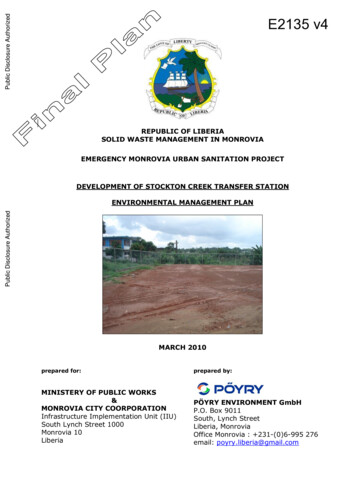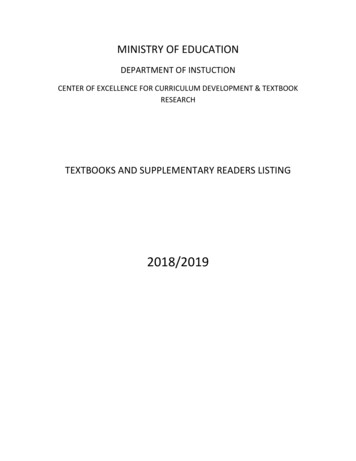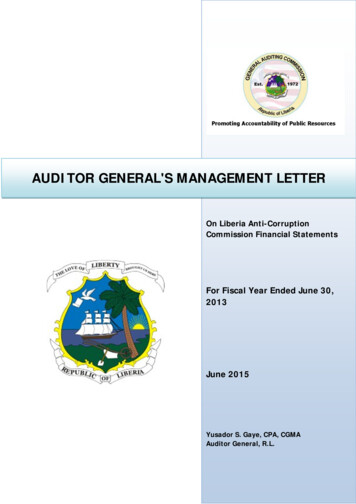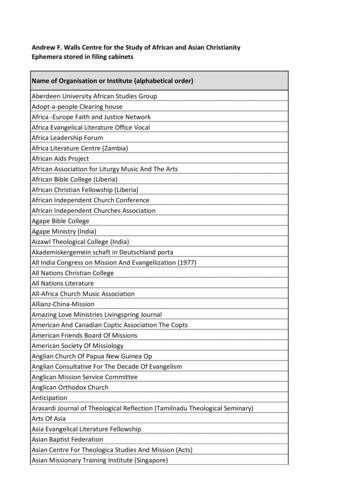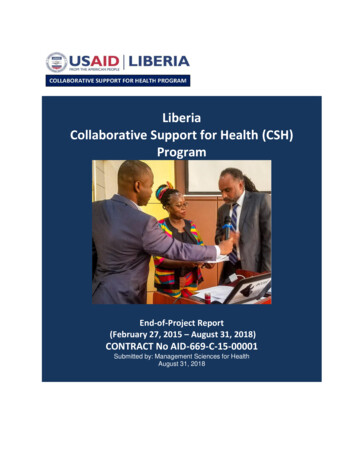
Transcription
LiberiaCollaborative Support for Health (CSH)ProgramEnd-of-Project Report(February 27, 2015 – August 31, 2018)CONTRACT No AID-669-C-15-00001Submitted by: Management Sciences for HealthAugust 31, 2018
This report is made possible by the support of the American People through the United States Agency forInternational Development (USAID). The contents of this report are the sole responsibility of the USAIDCollaborative Support for Health (CSH) Program and do not necessarily reflect the views of USAID or theUnited States Government. It was prepared by Management Sciences for Health for the USAIDCollaborative Support for Health Program, contract number AID-669-C-15-00001.Cover photo: Dr Wilhelmina Jallah, Minister of Health, receives the official copy of the National HealthQuality Strategy from Mervyn Farroe, USAID Deputy Mission Director.Photo by MSHUSAID Collaborative Support for Health (CSH) ProgramEnd of Project Report2
Acronyms and P Academic Consortium to Combat Ebola in LiberiaArtemisinin Combination TherapyAnatomical Therapeutic ChemicalUnited States Centers for Disease Control and PreventionClinton Health Access InitiativeCounty Health BoardCounty Health TeamCertified MidwifeContinuing Professional DevelopmentCivil Service AgencyCollaborative Support for Health ProgramDevelopment Education Network of LiberiaDistrict Health Information SystemDistrict Health TeamDevelopment Innovations GroupEbola Emergency FundElectronic Logistics Management Information SystemEssential Package of Health ServicesEuropean Union Technical AssistanceEnd-User VerificationEbola Virus DiseaseFixed Amount Reimbursement AgreementFiscal YearGovernance and Decentralization unitGovernment of LiberiaHealth Financing UnitHealth Information SystemsHMIS, Monitoring and Evaluation, and Research Unit (MOH)Health Management Information SystemHuman ResourcesHuman Resources for HealthHuman Resource OfficerImprovement CollaborativeImprovement Collaborative NetworkIntegrated Human Resources Information SystemInfection Prevention and ControlIn-Service TrainingJoint Integrated Supportive SupervisionJoint Sector ReviewLiberian Board of Nursing & MidwiferyLeadership Development Program PlusUSAID Collaborative Support for Health (CSH) ProgramEnd of Project Report3
LHEFLIPALMDCL M RBHSRDFRMPSCMSCMUSOPSPTATBTORTOTLiberia Health Equity FundLiberian Institute of Public AdministrationLiberia Medical and Dental CouncilLeadership, Management, and GovernanceLogistics Management Information SystemLiberian Pharmacy BoardMonitoring and EvaluationMaster Health Facility ListMaster Health FacilityMalaria in PregnancyMinistry of HealthMinistry of Public WorksManagement Sciences for HealthNational Diagnostics UnitNongovernmental organizationNational Health Quality StrategyNational Health and Social Welfare Policy and PlanNational Malaria Control ProgramOffice of Financial ManagementOfficer in ChargePerformance-Based FinancingPlan-Do-Study-ActPublic Financial ManagementPublic Financial Management Risk Assessment FrameworkPresident’s Malaria InitiativePeer Review Learning SessionPre-service TrainingQuality Assurance and Quality ImprovementQuality ManagementQuality Management TeamQuality Management UnitResults for DevelopmentResults-Based FinancingRebuilding Basic Health SystemsRevolving Drug FundRisk Mitigation PlanSupply Chain ManagementSupply Chain Management UnitStandard Operating ProcedureSulfadoxine-pyrimethamineTechnical AssistanceTuberculosisTerms of ReferenceTraining of TrainersUSAID Collaborative Support for Health (CSH) ProgramEnd of Project Report4
TNATWGUHCUNUNDPUNFPAUNICEFUSAIDUSGWASHWHOTraining Needs AssessmentTechnical Working GroupUniversal Health CoverageUnited NationsUnited Nations Development ProgramUnited Nations Population FundUnited Nations Children’s FundUnited States Agency for International DevelopmentUnited States GovernmentWater, Sanitation, and HygieneWorld Health OrganizationUSAID Collaborative Support for Health (CSH) ProgramEnd of Project Report5
Table of ContentsACRONYMS AND ABBREVIATIONS . 3TABLE OF CONTENTS . 61.EXECUTIVE SUMMARY . 72.INTRODUCTION . 93.ACHIEVEMENTS BY OBJECTIVE . 14OBJECTIVE 1.INSTITUTIONALIZE QA/QI INITIATIVES TO IMPROVE HEALTH CARE SERVICE DELIVERY . 15OBJECTIVE 2.STRENGTHEN HUMAN RESOURCES FOR HEALTH MANAGEMENT . 24OBJECTIVE 3.IMPROVE SUPPLY CHAIN MANAGEMENT . 40OBJECTIVE 4.STRENGTHEN THE HEALTH MANAGEMENT INFORMATION SYSTEM . 48OBJECTIVE 5.INCREASE THE FINANCIAL SUSTAINABILITY OF SERVICES. 55OBJECTIVE 6.(FORMERLY OBJECTIVE 1) DEVELOP LEADERSHIP, MANAGEMENT, AND GOVERNANCE CAPACITY OF THE MOH. 61OBJECTIVE 7.(FORMERLY OBJECTIVE 2) STRENGTHEN MPW CAPACITY TO MANAGE WATER SUPPLY INFRASTRUCTUREIMPROVEMENTS 67IMPROVING MANAGEMENT OF MALARIA . 694.CHALLENGES AND LESSONS LEARNED . 72ANNEXES. . 75ANNEX 1. INITIAL RESULTS FRAMEWORK . 75ANNEX 2. TECHNICAL DOCUMENTS INVENTORY . 76USAID Collaborative Support for Health (CSH) ProgramEnd of Project Report6
1. Executive SummaryFollowing the Ebola Virus Disease (EVD) outbreak, USAID’s Collaborative Support for HealthProgram (CSH) (February 2015–August 2018) advanced and improved the health system byworking in close partnership with the Government of Liberia (GOL). The program wasintentionally designed to focus on priority areas aligned with the GOL’s 2011-2021 NationalHealth and Social Welfare Policy and Plan (NHSWPP) and the National Investment Plan forBuilding a Health System 2015-2021. Led by Management Sciences for Health (MSH) withpartners Development Innovations Group (DIG), Institute for Healthcare Improvement (IHI),Jhpiego, and Results for Development (R4D), CSH assisted the Ministry of Health (MOH) in sixcounties—Bong, Lofa, Nimba (base counties), Margibi, Montserrado, and Grand Bassa (EbolaEmergency Fund [EEF] counties)—to accelerate progress toward the country’s priorities.Working both at the central and county levels, CSH strengthened the MOH’s overall capacity toput policies, procedures, and systems in place to make available high-quality health services toimprove the health status of Liberians.Working in support of the MOH, CSH’s scope of work spanned seven objectives:Objective 1. Institutionalize QA/QI initiatives to improve health care service deliveryObjective 2. Strengthen human resources for health managementObjective 3. Improve supply chain managementObjective 4. Strengthen the health management information systemObjective 5. Increase the financial sustainability of servicesObjective 6. Develop leadership, management and governance capacityObjective 7. Strengthen Ministry of Public Works capacity to manage water supplyinfrastructure ImprovementsThe CSH Program was implemented through a lean team of staff in the Monrovia office, withleadership by the Chief of Party, Deputy Chief of Party, Health Systems Strengthening Advisor,and M&E Director. Project Coordinators for the EEF and Base Counties were later introduced tocoordinate activities of counties through County Team Leads. The program’s approach hadtechnical advisors embedded in the MOH at the central level, and mentors that worked side-byside with counterparts in the county health teams, contributing heavily to the program’sachievements. Achievements across objectives that CSH either contributed to or led directlyover the life of the project ranged from policy development to county-level laboratory capacityassessments. A few of CSH’s key achievements were as follows:Under objective 1, CSH supported the MOH in developing the Liberia National HealthcareQuality Strategy (NHQS) that guides establishment of quality services in the country. Thestrategy, together with the Infection Prevention and Control (IPC) policy, was launched by theMOH in June 2018 and disseminated for wider use thereafter. In support of the MOH’s strategy,CSH supported the revision of the Joint Integrated Supportive Supervision (JISS) tool to monitorcore clinical standards of the Essential Package of Health Services (EPHS) at the primary level.Under objective 2, CSH responded to the MOH and Governance Commission’s request byfacilitating the restructuring of three Human Resources for Health (HRH) units into an integratedsingle HR department, which was subsequently approved by the senior MOH leadership. WithCSH support, the MOH and its partners developed a new MOH Staff Handbook that wasdisseminated to the six Program counties to guide officers in charge (OICs) and county healthteams (CHTs) on HRH management. All hospitals and CHTs in the six counties have copies ofUSAID Collaborative Support for Health (CSH) ProgramEnd of Project Report7
the new MOH Staff Handbook and can use it as a reference to effectively recruit and managestaff. In addition, CSH supported the installation of and training in the integrated HumanResources Information System (iHRIS) in all counties to improve accuracy and quality ofworkforce data. As a result of these efforts, for example, Bong CHT has an improved andfunctional HR record-keeping system with 81% (1,065/1,310) of health workers with completepersonnel files and 78% (1,022/1,310) of staff records uploaded into iHRIS-Manage.Under objective 3, CSH supported implementation of the redesigned paper-based LogisticsManagement Information System (LMIS). This system is now established in 15 counties, and inFY18 Q2, 66% of CSH-supported health facilities reported LMIS data to the national SupplyChain Management Unit, 55% of health facilities reported on time, and 65% of health facilitiesprovided complete data. Furthermore, CSH supported the MOH to design a prototype of anelectronic LMIS (eLMIS) to ease the burden of LMIS data management and reporting. Atprogram end, eLMIS had been rolled out to 6 USAID-supported counties.Under objective 4, CSH supported the finalization of the MOH Financial Management Policiesand Procedures manual - enabling the MOH and counties to review and install appropriateaccounting, procurement, audit, asset, and risk-management procedures. In addition, CSHplayed a key role as an analytical partner and strategic adviser to the MOH in health financingreform having: 1) partnered with the World Bank to develop an Liberia Health Equity Fund(LHEF) policy note; 2) conducted a Willingness to Pay Study and Consumer Preference Surveyto inform strategic purchasing; 3) supported a National Stakeholder Health Financing Dialogue;and 4) assisted in updating the 2016 EPHS costing to inform the design of FARA 2.Under objective 5, CSH supported the finalization of the national Health ManagementInformation System (HMIS) Strategic Plan and subsequent partner mapping, revised thenational HMIS ledgers, and developed a data validation SOP. Program data showed improvedhealth facility HMIS reporting (both on time and completeness) in the base three counties from73% in Q2 2015 to 91% in Q2 2018. Furthermore, the project supported the MOH indevelopment of a Health Information System (HIS) interoperability roadmap and implementationplan, and supported finalization of interoperability domains and subsystems like the masterhealth facility list and registry, and the ATC coding system for drugs and commodities inalignment with Liberia MOH DHIS2 indicator list.Under objective 6, CSH provided technical assistance to the MOH to develop and finalize theCounty Health Board (CHB) Operational Manual and Facilitator’s Guide for strengtheningoversight and management of quality and equitable health service delivery at the county level.For the first time, the CHT in Bong shared and discussed county health achievements, financialinformation and next quarter plans with the CHB for its inputs and support in conformity with theCHB’s role as a governance body. CSH also built capacity (i.e. through developing acontinuous professional development policy, developing annual operational plans) of threeLiberia professional bodies (the Liberia Board of Nursing and Midwifery, Liberia PharmacyBoard and the Liberia Medical and Dental Practitioners Council) to better manage licensing ofhealth professionals and health facilities in the country.Finally, under objective 7, CSH facilitated the Ministry of Public Works (MPW) joint water,sanitation, and hygiene (WASH) sector review and wrote the 2014/15 sector performancereport. The project also facilitated development of a policy and sanction instruction that allowedthe MPW to require nongovernmental organizations working in the WASH sector to report theirwater point achievements and to include them in the water point atlas.USAID Collaborative Support for Health (CSH) ProgramEnd of Project Report8
These achievements are particularly notable given the challenging implementing environment.Launching the ambitious program during the Ebola crisis and then implementing it in itsaftermath presented many unexpected challenges as well as opportunities towards long-termhealth system strengthening outcomes and more immediate quantifiable results through shortterm health system support and inputs. This report shares progress made over the three yearperiod as well as lessons and recommendations to contribute to learning on systemsstrengthening for health in a post-crisis environment.2. IntroductionThe USAID Collaborative Support for Health Program (CSH) (February 2015–August 2018)provided targeted health systems strengthening technical assistance (TA) to the Government ofLiberia (GOL). The Program worked at the central and county levels to improve the health statusof Liberians by strengthening the Ministry of Health (MOH)’s overall capacity to consistently andeffectively deliver high-quality health services. Led by Management Sciences for Health (MSH),the CSH Program assisted the MOH in six counties—Bong, Lofa, Nimba, Margibi, Montserrado,and Grand Bassa (see Figure 1)—to accelerate progress toward the country’s priorities for qualityhealth care improvement. Initially the Program focused on three counties: Bong, Lofa, and Nimba,with the second three added in 2017 following the devastating 2014-2015 Ebola Virus Disease(EVD) outbreak.Over the life of the Program, CSH supportedthe design and implementation of capacityThe Collaborative Support for Health Program was abuilding and health systems strengtheningUSAID contract to support the design andactivities at both levels (county and central).implementation of capacity-building and healthTo achieve the GOL’s health goals, CSHsystems strengthening activities at the central levelworked alongside the MOH and Ministry ofand in targeted counties in alignment with thePublic Works (MPW), together with partnersInvestment Plan for Building a Resilient HealthJhpiego, Results for Development (R4D),System.Institute for Healthcare Improvement, andDevelopment Innovations Group (DIG).The Program was designed to focus on priority areas aligned with the GOL’s 2011-2021 NationalHealth and Social Welfare Policy and Plan (NHSWPP) and the National Investment Plan forBuilding a Health System 2015-2021. Following the Ebola epidemic, in 2015 the MOH articulateda refined vision to guide partners to consolidate resources in rebuilding the health system: theNational Investment Plan for Building a Resilient Health System 2015–2021. The Investment Planwas intended to “restore the gains lost due to the [Ebola] crisis, provide health security for thepeople of Liberia by reducing risks due to epidemics and other health threats, accelerate progresstowards universal health coverage by improving access to safe and quality health services, andnarrow the equity gap for the most vulnerable populations.”Working with partners, CSH supported the implementation of activities aimed at improving thehealth status of Liberians. The Program’s overall strategy was to provide integrated healthsystems support to the MOH as it implemented its national health strategies and plans. TheUSAID Collaborative Support for Health (CSH) ProgramEnd of Project Report9
coordinated comprehensive support provided under the Program to the health sector (and brieflyto the MPW) included leadership, management, and governance; advancing quality of care;strengthening the health workforce; ensuring the availability of medicines; and improving financialmanagement and data systems.Figure 1. CSH-supported countiesInitial ‘base’ project focusEbola Emergency Fundcounties added after the EbolaoutbreakThe CSH Program was initially organized around seven specific objectives:11. Strengthen leadership and governance capacity at all levels2. Strengthen the MPW’s capacity to manage water supply infrastructureimprovements3. Institutionalize quality assurance (QA) and quality improvement (QI) initiatives toimprove health care service delivery4. Strengthen human resources for health management5. Improve supply chain management6. Increase financial sustainability of health services7. Strengthen the health management information systemIn February 2017, when USAID awarded MSH additional funding from the Ebola Emergency Fund(EEF) to expand CSH’s health system strengthening activities to three counties most affected byEbola (Grand Bassa, Margibi, and Montserrado), interventions in these countries were designed1See annex for the initial results framework for the ProgramUSAID Collaborative Support for Health (CSH) ProgramEnd of Project Report10
to scale up achievements, best practices, and proven strategies from the base counties and tosupport three key objectives:1. Strengthen capacity of health facilities in the three counties to practice infection preventionand control (IPC) standards and provide health services according to the National HealthQuality Strategy and Plan.2. Support implementation of the national Health Information System (HIS) and accelerateimprovements to health and logistics information systems.3. Strengthen county health team (CHT) capacities and systems in Grand Bassa, Margibi,and Montserrado counties to manage the restoration of health services and strengthencore systems functions.Entering program year four (PY4), and following the mid-term evaluation of the Program, thescope of the CSH Program was refined under the directive of USAID, and activities for Objective1, Leadership, Management, and Governance (L M G); Objective 2, Water, Sanitation, andHygiene (WASH); and some activities under Objective 3 at the county level were eliminated. Therevised objectives included: 1) increasing the availability of quality health services byinstitutionalizing quality assurance at the county, district, and facility levels; 2) strengtheningHuman Resources for Health (HRH) management to help create a more “fit for purpose”workforce; 3) improving supply chain management by increasing capacity to manage essentialmedicines; 4) strengthening the Health Management Information System (HMIS) to be moreresponsive; and 5) improving sustainability of health services by strengthening key financialsystems and generating evidence to inform health financing reforms in the country. The CSHProgram Results Framework (Figure 2) was realigned accordingly and the Program’sperformance Management Plan was revised to better capture the Program’s intended outputsand outcomes.USAID Collaborative Support for Health (CSH) ProgramEnd of Project Report11
Figure 2: Revised CSH Program Results FrameworkIn March 2018, a decision was made to close the Program earlier than anticipated, with theProgram end date moved to August 2018. As part of its close-out strategy, the CSH team andUSAID CSH Contracting Officer Representative (COR) held a series of close-out consultativemeetings with key stakeholders to communicate the close-out timelines, outstanding activities,and key challenges, and to develop transition plans and identify additional support required tofinish some activities started under CSH.USAID Collaborative Support for Health (CSH) ProgramEnd of Project Report12
Photo by Cindy ShinerPhebe Hospital outpatient clinic, Bong County. Strengthening the capacity of thehealth workforce was among the CSH Program’s objectives.Despite theearly close-out, over the life of the project, CSH was able to support the MOH to achieve severalof its goals because of the Program’s design and approach. The CSH Program was aligned withthe MOH’s policies and plans and followed USAID’s Human and Institutional CapacityDevelopment model. In all activities, the Program followed the lead of the MOH to support itsefforts with critical inputs of technical support and financial and other resources to implement itslong-term plans, ensuring MOH involvement, leadership, and buy-in at all points in the Program.Although, at times, this meant delays in approvals or in finalizing products, the outcome was aproduct that was led and owned by the MOH, the entity ultimately responsible for implementingand maintaining progress. The support was designed and provided in such a way that the MOHand partners jointly created the systems, tools, and resources, and developed the in-house skillsand abilities to use and manage these tools and resources that are needed to meet the MOH’s2021 health system goals.USAID Collaborative Support for Health (CSH) ProgramEnd of Project Report13
At the central level, the Program’s embedded advisorsprovided intensive TA to the MOH with criticalrealignment of systems, ensuring that management“My team has been thinking aboutassessing our performance everystructures and guidance were clear, that thequarter, but we did not know where toinformation needed to effectively manage thestart. Now that we have beencomponents of the health system were available, andintroduced to this tool, we will use it tothat systems for improving skills were in place. At theconduct our self-assessment everycounty level, building on MSH experience in otherquarter and create improvementcountries, CSH embedded mentors into the CHTs toplans.”provide on-site support to the CHT staff.1 HR mentors,– Member of CHT commenting on thesupply chain mentors, a public financial managementHSS Capacity Assessment Tool.mentor, QI mentors, and M&E mentors wereembedded with the CHTs to provide daily support andTA in a coordinated manner. The mentors worked withthe CHTs to revise and revamp the county-levelinfrastructure and systems to allow them to efficiently spend time managing services andimproving quality, while enhancing client services.Details of the CSH Program activities and outcomes over the three and a half years of theProgram are provided below and organized by the Program objective. To facilitate reporting onthe expenditure of malaria funds, that activity area has been pulled into its own section underObjective 4. In addition, each section describes activities that were transitioned to the MOH orother partners when the Program ended, as well as provides recommendations for futureprogramming.3. Achievements by ObjectiveRapid baseline county-level capacity assessments were conducted in both base and EEFcounties to guide the capture of data on the status and capacity of local health systems. Findingshelped to identify health system strengthening gaps and guide program interventions. Theassessment was conducted with County Health Teams (CHTs) utilizing a County Health SystemStrengthening (HSS) Capacity Assessment tool. The tool – initially developed by USAID’sRebuilding Basic Health Services (RBHS) project - was revised by CSH in consultation with theMOH in order to strengthen and broaden the assessment.The outcome, results, transition plans and recommendations of the program discussed in thissection are organized thematically following the order of the revised results framework. This isfollowed by the two objectives that were dropped midway: Objective 1.Objective 2.Objective 3.Objective 4.Objective 5.Institutionalize QA/QI initiatives to improve health care service deliveryStrengthen human resources for health managementImprove supply chain managementStrengthen the health management information systemIncrease the financial sustainability of servicesUSAID Collaborative Support for Health (CSH) ProgramEnd of Project Report14
Objective 6 Objective 7Malaria(formerly Objective 1). Develop leadership, management and governancecapacity(formerly Objective 2). Strengthen MPW capacityObjective 1. Institutionalize QA/QI initiatives to improve healthcare service deliveryThe service delivery building block encompasses many things, including QA and QI systems.Health care quality issues are reflected in the wide variations in utilization, from underuse,overuse, or misuse of services, to inadequate provision of services and assignment of poorlytrained staff by the health system. Quality is broadly defined as addressing prevention and careprocesses, quality of equipment, and, above all, quality of staff delivering the services. With thesupport of the CSH Program, the MOH has taken action to address these issues by updating thequality standards of care and creating an environment in which these standards can be effectivelyimplemented, assessed, and measured in order to determine gaps and bring about solutions. Byworking closely with the MOH to create a home for quality within the MOH and by developingsystems, standard operating procedures (SOPs), processes, measures, and tools, CSH wasjointly able to achieve the following high-level outcomes: Establishment of a Quality Management Unit responsible (QMU) for setting the directionand developing standards and institutionalizing QA/QI at all levels of health care deliveryDevelopment and launch of a National Health Quality Strategy (NHQS)Establishment of Quality Management Teams (QMTs) within the counties/facilitiesUpdate the MOH Quality Standard and Joint Integrated Supportive Supervision (JISS)tools for national, district, and county levels; 231 of 323 facilities were visited in the sixCSH-supported countiesUSAID Collaborative Support for Health (CSH) ProgramEnd of Project Report15
Background and contextQA/QI and IPC strategies were not comprehensivelyaddressed in the health care system before the EVDepidemic, and the MOH didn’t have an internal framework forcoordinating and collaborating among partners working inservice delivery QI. During the epidemic, the need for moreeffective IPC stood out dramatically as many people,including health workers, contracted the virus in healthfacilities. An Infection Prevention and Control Committee wasformed during the epidemic; although this remained in place,some felt that rather than doing IPC as a stand-aloneapproach, it should be integrated into quality management.When the EVD epidemic subsided, the MOH began exploringa comprehensive approach to institutionalized QA/QI andIPC to improve the quality of health care services provided atfacilities in support of the MOH goal of building a resilienthealth system by 2021.The MOH, in its 10-year NationalHealth Policy and Plan 2011–2021highlighted its vision to optimize thedelivery of quality health services andimprove access to safe and qualityhealth services. This was reinforcedas one of the MOH’s priorities in the2015–2021 National Investment Planfor Building a Resilient Health Systemfollowing the EVD outbreak. TheInvestment Plan proposes to improveboth quality of care and access tohealth services, and aims to promotemonitoring of the adherence toclinical standards and practices aswell as means for monitoringperformance for improvement ofservices.CSH began its work in this area with consultative meetingswith counterparts at the MOH and with in-country partners tounderstand MOH priorities and align activities with ongoingQA/QI initiatives. The process for developing the CSHProgram TA approach for QA/QI began with joint discussions involving the MOH and partners ata quality management technical working group (TWG) on integrating quality into the generalframework of service delivery. CSH also held scoping visits to assess the landscape and to getstakeholder input on quality issues, needs, existing plans, etc. CSH led a series of stakeholderdiscussions to identify key drivers of poor quality, how to define quality in Liberia, etc., to informthe TA approach.CSH QA/QI activities changed focus over the life of the project, but included collaborating witht
technical advisors embedded in the MOH at the central level, and mentors that worked side-by- . Board and the Liberia Medical and Dental Practitioners Council) to better manage licensing of health professionals and health facilities in the country. Finally, under objective 7, CSH facilitated the Ministry of Public Works (MPW) joint water,
